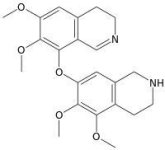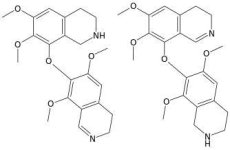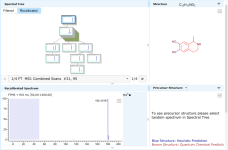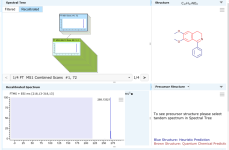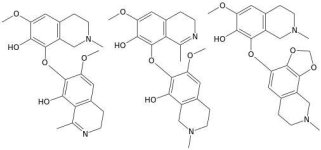-
Members of the previous forum can retrieve their temporary password here, (login and check your PM).
You are using an out of date browser. It may not display this or other websites correctly.
You should upgrade or use an alternative browser.
You should upgrade or use an alternative browser.
Research The Cactus Analysis Thread
- Thread starter endlessness
- Start date
Research done by (or for) the DMT-Nexus community
Migrated topic.
DrSeltsam
Rising Star
endlessness, As a first step I would ask someone to help us with the results of the LS-MS from EC. At the moment I can not make so much sense of what we are looking at.
I have a book (in German) that lists a lot of secondary compounds in psychoactive cacti. I used this as a reference to see if I would find any of these chemicals in the spectra provided by urtica. Without success. Anyhow, Shulgin synthesized a lot of these chemicals to test them and none of them are really active (at least on its own).
So I wonder what a good strategy would look like to figure out what compounds would be responsible for the added effects (that do not come from mescaline). Any ideas on this?
Some time ago I did an extraction of Peruvian Torch which I acquired in dry form to yield the HCl salt (I don’t belief in this hipster vinegar stuff ). I purified the extract heavily and collected the “waste” from the purification on the side. These should have a really high concentration of non-mescaline alkaloids. As I do not know the strain of the cactus this came from, I wonder if it even makes sense to spend the money to do the analysis.
). I purified the extract heavily and collected the “waste” from the purification on the side. These should have a really high concentration of non-mescaline alkaloids. As I do not know the strain of the cactus this came from, I wonder if it even makes sense to spend the money to do the analysis.
I have a book (in German) that lists a lot of secondary compounds in psychoactive cacti. I used this as a reference to see if I would find any of these chemicals in the spectra provided by urtica. Without success. Anyhow, Shulgin synthesized a lot of these chemicals to test them and none of them are really active (at least on its own).
So I wonder what a good strategy would look like to figure out what compounds would be responsible for the added effects (that do not come from mescaline). Any ideas on this?
Some time ago I did an extraction of Peruvian Torch which I acquired in dry form to yield the HCl salt (I don’t belief in this hipster vinegar stuff
Hey!
Can you sum up what questions you want to be asked at EC?
As for the compounds for "added effects", how are you sure there are added effects in the first place? In an earlier post you mentioned the 'speedy effects' or something of the sort.. But was there a blind test to show this? Ism't it possible its related to set and setting, self suggestion, and/or simply different dosages of mescaline being consumed at different times?
As for testing the extract and "waste" you have, yes lets do it! No money needed:
Please describe how you did the purification and what is the "waste" you collected in that thread, get the extracts together and ready to be sent and pm me

Can you sum up what questions you want to be asked at EC?
As for the compounds for "added effects", how are you sure there are added effects in the first place? In an earlier post you mentioned the 'speedy effects' or something of the sort.. But was there a blind test to show this? Ism't it possible its related to set and setting, self suggestion, and/or simply different dosages of mescaline being consumed at different times?
As for testing the extract and "waste" you have, yes lets do it! No money needed:
Please describe how you did the purification and what is the "waste" you collected in that thread, get the extracts together and ready to be sent and pm me
unknown 1 looks to me like DMPEA
with fragmentation peaks
DMPEA-NH2 at 165
DMPEA-CH2NH2 at 150
i have no idea what the high MW long retention time compounds are.. if they are very non-polar to get stay in the column so long perhaps they are not alkaloids
although, unknown #2 only eluted at 7.6min, so maybe that one is an alkaloid? what would have a peak at 400m/z?
----
edit:
Then again, it actually is closer pattern to MDPEA since the +1 of the proton for the charge..
with fragmentation peaks
DMPEA-NH2 at 165
DMPEA-CH2NH2 at 150
i have no idea what the high MW long retention time compounds are.. if they are very non-polar to get stay in the column so long perhaps they are not alkaloids
although, unknown #2 only eluted at 7.6min, so maybe that one is an alkaloid? what would have a peak at 400m/z?
----
edit:
Then again, it actually is closer pattern to MDPEA since the +1 of the proton for the charge..
DrSeltsam said:Thanks for your hints, Mindlusion!
Stange that we do not see the M+H peak for DMPEA? I would not see why it wold be less stable than Mecaline, which you see at 212. Any idea why?
For MDPEA: very interesting idea. Are you aware if this was ever observed in cacti before?
Hmm I always thought MDPEA was observed before, but I could be mistaken. Maybe it has not at all. Anyway I change my mind I like DMPEA better option here, I miscounted the mass again.
Not sure why we do not see the M+H peak. I assume that since the M+H peak in mescaline is very small, and even cannot see it sometimes in some crude spectra, I figure it might just be a concentration thing or obstructed by noise so we do not see the DMPEA M+H peak.
DrSeltsam
Rising Star
endlessness,
Wow. Thanks for the offer
I did a slight modification of ron69's tek for myself which is much faster than what he proposes but you need to be a bit more careful and an induction stove
I have done the following adjustments:
I salt with 50 mL of very diluted HCl*dH2O (~ pH 3-4) a couple of times until the pH does not change any more. I used to put the 50 mL in a ceramic pot on my induction stove and got rid of the water quickly (no problem with good temperature control).
I wash the salts twice with dry acetone, once with dry IPA, boil the remaining part in dry Acetone:IPA 5:1 (freeze afterwards) and wash one more time with dry Acetone. The remaining substance only slightly off-white and has no odour any more.
There is a number of questions I would address with LC-MS:
1.) When I use lower pH when salting I seem to pull out a lot of stuff from the NPS, as Ron mentioned. I would do an extraction, split the NPS in two parts, and compare the pulls before and after cleaning. If the junk is washed out anyway , I might as well salt with pH 1 and do not care about all the pH control anyhow.
2.) Test how good the clean up is at all. How pure is the final product? What is removed?
3.) Where does the smell come from? I think it is very odd that a salted product has a smell.
4.) When combining everything that remains when evaporating the solvents from the washes and weighing this, this is not equal to the mass I loose when I weight the remainder that did not dissolve in Aceton/IPA. In other words: when doing the purification, I loose some mass - about 10-30%. This might be water or something else. Perhaps this could shed some light onto this.
What do you think?
Wow. Thanks for the offer
I did a slight modification of ron69's tek for myself which is much faster than what he proposes but you need to be a bit more careful and an induction stove
I have done the following adjustments:
I salt with 50 mL of very diluted HCl*dH2O (~ pH 3-4) a couple of times until the pH does not change any more. I used to put the 50 mL in a ceramic pot on my induction stove and got rid of the water quickly (no problem with good temperature control).
I wash the salts twice with dry acetone, once with dry IPA, boil the remaining part in dry Acetone:IPA 5:1 (freeze afterwards) and wash one more time with dry Acetone. The remaining substance only slightly off-white and has no odour any more.
There is a number of questions I would address with LC-MS:
1.) When I use lower pH when salting I seem to pull out a lot of stuff from the NPS, as Ron mentioned. I would do an extraction, split the NPS in two parts, and compare the pulls before and after cleaning. If the junk is washed out anyway , I might as well salt with pH 1 and do not care about all the pH control anyhow.
2.) Test how good the clean up is at all. How pure is the final product? What is removed?
3.) Where does the smell come from? I think it is very odd that a salted product has a smell.
4.) When combining everything that remains when evaporating the solvents from the washes and weighing this, this is not equal to the mass I loose when I weight the remainder that did not dissolve in Aceton/IPA. In other words: when doing the purification, I loose some mass - about 10-30%. This might be water or something else. Perhaps this could shed some light onto this.
What do you think?
Sounds good to me  Get samples ready and let me know !
Get samples ready and let me know !
Mindlusion, thanks for the feedback here!
Mindlusion, thanks for the feedback here!
Ulim
Rising Star
Is there any analsysis data on non psychoactive cacti grafted onto psychoactive ones?
I was reading up on achlorophyllous cacti like the hibotan which always need grafting stocks to "feed" them and was wondering how much of the mescaline actually gets transported over into the grafted cactus.
Given the fact that all the enzymes for the production would spawn in the stock and move around I would expect the stock to still be more potent but some would go into the graft.
But maybe if there are cacti around with a higher bioprecursor output one could create a symptiotic psychoactive relationship where the stock would provide the "blueprints" and the graft the "building blocks".
I would support analysis of fast growing non psychoactive cacti for precursors of interest.
I was reading up on achlorophyllous cacti like the hibotan which always need grafting stocks to "feed" them and was wondering how much of the mescaline actually gets transported over into the grafted cactus.
Given the fact that all the enzymes for the production would spawn in the stock and move around I would expect the stock to still be more potent but some would go into the graft.
But maybe if there are cacti around with a higher bioprecursor output one could create a symptiotic psychoactive relationship where the stock would provide the "blueprints" and the graft the "building blocks".
I would support analysis of fast growing non psychoactive cacti for precursors of interest.
Attachments
downwardsfromzero
Boundary condition
Is that the 399.0 peak? Would this be as M+H?Mindlusion said:what would have a peak at 400m/z?
If so, a molecular formula of C21H22N2O6 checks out (M+H=399.42), plugging that into PubChem gives nothing. This is, of course, shooting in the dark and without NMR it'll be bloody difficult. Trial and error variations (by hand, at least) will take ages. I've had a brief look for an online MW to formula converter - there must be one somewhere - but to no avail, they all convert formulas to MW but not the other way round. And a molecular formula can correspond to thousands of compounds so that's not much help.
That given, here's the results of my brainstorming:
That MW is in the range of a tripeptide: C23H17N3O4 = 399.40. That's rather short on hydrogens, though.
Or a dimeric isoquinoline, maybe with an oxygen bridge (as in pilocereine): C22H26N2O5 = 398.45
This would be plausible, and I've attached a couple of structural formulas that would be both possible and likely. Maybe this helps - I certainly hope so!
EDIT: the lower of the two rings in each structure has a 5,6,7-oxygen substitution pattern which is unknown among the cacti, it was drawn this way because it was easier than drawing the more usual 6,7,8-substitution pattern! (And of course, the methylenedioxy-substituted cactus isoquinoline alkaloids have this moiety at the 7,8-position.)
Attachments
downwardsfromzero
Boundary condition
On the basis of the observations added at the end of my last post, here are two further structures that I consider the most plausible, with an analogy to the 7>8 oxygen bridge seen in pilocereine.
(I couldn't bear my own slackness :roll: )
Thinking about it, the 7 and 8' methyl groups should probably be on the 1,1'- or N,N'-positions...
(I couldn't bear my own slackness :roll: )
Thinking about it, the 7 and 8' methyl groups should probably be on the 1,1'- or N,N'-positions...
Attachments
DrSeltsam
Rising Star
downwardsfromzero, cool ideas 
If I compare these ones to spectra on mzcloud.org I notice that the heterocyclic amines do not really fragment as the M+H is too stable (when a double bond is there) or after breaking a bond the molecule still stays intact. I attached to electronspray spectra as a reference.
Edit: In case of the nitrogen has a double bond, there is normally no fragmentation. When there are only single bonds, there is fragmentation. Sorry for the mistake.
If I compare these ones to spectra on mzcloud.org I notice that the heterocyclic amines do not really fragment as the M+H is too stable (when a double bond is there) or after breaking a bond the molecule still stays intact. I attached to electronspray spectra as a reference.
Edit: In case of the nitrogen has a double bond, there is normally no fragmentation. When there are only single bonds, there is fragmentation. Sorry for the mistake.
Attachments
downwardsfromzero
Boundary condition
Thanks, here's another revision based on further consideration as perDrSeltsam said:downwardsfromzero, cool ideas
plus one with the methylenedioxy group in the 'correct' place for cacti (because mindlusion likes a nice methylenedioxyThinking about it, the 7 and 8' methyl groups should probably be on the 1,1'- or N,N'-positions...
 )
)Attachments
Zackmorris999
Rising Star
Were the entire cuttings used for all of these extractions, or did you discard the core, outer skin, spines, etc?



